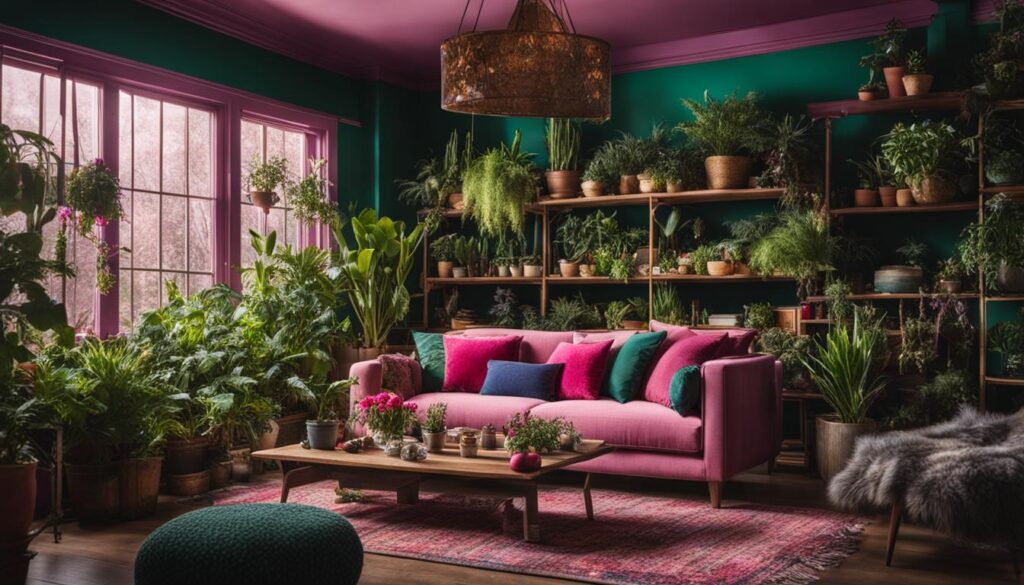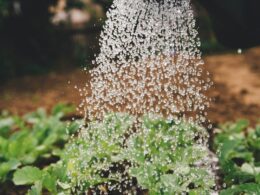Growing plants indoors during the winter months can be a rewarding experience for plant enthusiasts. Whether you’re a first-time plant owner or looking to improve your success rate, there are several factors to consider. Light is one of the most important elements for plant growth, and understanding the specific needs of your plants in relation to the available light is crucial. Proper watering techniques, humidity levels, temperature control, air circulation, and choosing the right plants for your home are also key factors to ensure success in growing plants indoors during winter.
Key Takeaways:
- Understanding the light requirements of indoor plants is essential for successful winter gardening indoors.
- Proper watering techniques, such as watering when the top inch of soil is dry, are crucial for plant health in winter.
- Increasing humidity levels and maintaining optimal temperature and air circulation are important factors to consider.
- Choosing the right plants for indoor winter gardening ensures their ability to thrive in your home.
- With proper care and attention, you can cultivate a vibrant indoor garden even during the coldest months of the year.
Importance of Light for Indoor Plant Growth
Light is a vital component for indoor plant growth, as it serves as a source of energy through photosynthesis. Different plants have varying light requirements, and it’s important to match their needs with the available light conditions in your home. Understanding the importance of light and choosing the right plants based on light availability can greatly impact the success of your indoor gardening endeavors.
Indoor plants can be classified into three main categories based on their light requirements: high light, medium light, and low light plants. High light plants require direct sunlight for several hours a day and are best suited for south-facing windows. Examples of high light plants include succulents, cacti, and certain flowering plants.
Medium light plants can tolerate bright, indirect light and are suitable for east- or west-facing windows. These plants include ferns, spider plants, and pothos. Low light plants, on the other hand, can thrive in areas with minimal natural light, such as north-facing windows or rooms with few windows. Popular low light plants include snake plants, ZZ plants, and peace lilies.
Choosing the Right Plants based on Light Availability
When selecting plants for your indoor garden, consider the amount of light available in your home. Observe the different areas throughout the day to determine the light intensity and duration. If you have limited natural light, opt for low light plants that can thrive in these conditions. On the other hand, if you have bright, direct sunlight, choose high light plants that can take advantage of the abundance of light.
If your home lacks sufficient natural light, you can supplement it with artificial lighting. Incandescent bulbs, fluorescent lights, and LED lights can provide the necessary light energy for your plants. Position the lights about 12 to 18 inches above the plants and adjust their intensity and duration based on the plant’s light requirements. Keep in mind that different types of artificial lights emit different wavelengths, so choose the appropriate light source for your plants.
Remember to regularly monitor your plants for signs of light deficiency or excess. If the leaves appear pale, elongated, or wilted, it may indicate that they are not receiving adequate light. Overexposure to intense light, on the other hand, can lead to scorched or burnt leaves. Adjust the position and intensity of the light source accordingly to provide the optimal light conditions for your indoor plants.
Proper Watering Techniques for Indoor Plants
When it comes to taking care of your indoor plants during winter, proper watering techniques are crucial for their health and survival. Understanding how often and how much to water your plants can make a significant difference in their overall well-being. Here are some essential tips to help you master the art of watering indoor plants:
Determine the watering frequency
The watering frequency for indoor plants can vary depending on various factors such as the type of plant, humidity levels, and temperature. As a general rule of thumb, it’s recommended to water your plants when the top inch or two of soil feels dry to the touch. Avoid overwatering, as it can lead to root rot and other moisture-related issues. On the other hand, underwatering can cause stress and damage to the plants. Regularly monitor the moisture level of the soil to ensure that you are providing just the right amount of water.
Pay attention to plant-specific needs
Each plant has its own unique watering requirements, so it’s important to familiarize yourself with the specific needs of your indoor plants. Some plants prefer slightly drier conditions, while others thrive in consistently moist soil. Research the watering preferences of your plants and adjust your watering routine accordingly. Factors such as the plant’s native habitat and growth stage can also influence its water needs. By understanding your plants’ individual preferences, you can ensure that they receive the optimal amount of water.
Use room temperature water
When watering your indoor plants, it’s best to use room temperature water. Cold water straight from the tap can shock the plant’s roots and disrupt its growth. Fill a watering can or container with water and let it sit for a while to allow it to reach room temperature. This small step can help prevent any unnecessary stress to your plants.
By following these proper watering techniques, you can provide your indoor plants with the moisture they need to thrive during the winter months. Remember to adjust your watering routine based on the specific needs of your plants and the environmental conditions in your home. With a little care and attention, your indoor plants will flourish even in the colder season.
Maintaining Optimal Humidity Levels for Indoor Plants
Humidity plays a crucial role in the health and well-being of indoor plants, especially during the winter months when indoor heating can lower humidity levels. Providing the right amount of humidity for your plants is essential for their growth and overall survival. Here are some tips to help you maintain optimal humidity levels in your indoor garden:
Grouping Plants Together
One effective way to increase humidity levels around your plants is by grouping them together. When plants are placed close to each other, they create a microclimate with higher humidity due to transpiration. This is particularly beneficial for moisture-loving plants that thrive in tropical environments. However, be mindful of the specific humidity requirements of each plant, as some may be sensitive to excessive moisture.
Using Humidity Trays
Humidity trays are shallow trays filled with water that can be placed beneath your plant pots. As the water evaporates, it increases the humidity around the plants. For best results, choose trays with a wide surface area to maximize water evaporation. Additionally, placing pebbles or stones in the tray can prevent the plant’s roots from sitting directly in water, reducing the risk of root rot.
Misting Plants
Misting is another method to increase humidity levels for your indoor plants. Using a spray bottle, mist the leaves and surrounding air with clean, room temperature water. This provides a quick burst of moisture that can benefit moisture-loving plants and help alleviate dryness in the surrounding environment. However, avoid misting plants with fuzzy or hairy leaves, as excessive moisture can encourage the growth of fungal diseases.
Table: Humidity Preferences for Common Houseplants
| Plant | Optimal Humidity |
|---|---|
| Peace Lily | 40-60% |
| Fern | 40-50% |
| Orchid | 40-60% |
| Spider Plant | 40-50% |
| English Ivy | 40-60% |
Keep in mind that these values are general guidelines, and each plant may have specific humidity requirements. It’s important to research the needs of your individual plants to ensure they thrive in the appropriate humidity levels.
Maintaining optimal humidity levels is crucial for the health and vitality of your indoor plants. By implementing these methods, you can create a more suitable environment for your plants and increase their chances of flourishing during the winter months.
Temperature and Air Circulation Considerations for Indoor Plants
When it comes to growing plants indoors during the winter, temperature and air circulation are two important factors that require your attention. Maintaining the right temperature and ensuring proper air circulation can greatly influence the health and growth of your indoor plants. Here’s what you need to know:
Temperature:
Indoor plants generally thrive in temperatures between 65 to 75 degrees Fahrenheit during the day and above 50 degrees Fahrenheit at night. It’s essential to avoid placing your plants near drafts, such as windows, doors, or heating vents, as extreme temperature fluctuations can be harmful. These fluctuations can stress the plants and lead to problems like wilting, leaf damage, or even death. So, be mindful of the temperature conditions in your home and choose appropriate locations for your plants.
Air Circulation:
Air circulation plays a vital role in the overall well-being of your indoor plants. While plants benefit from fresh air movement, it’s essential to strike a balance to prevent issues such as pest infestations or excessive drying of the plant. A gentle breeze or a mild fan can help facilitate air circulation in the room, but avoid placing the fan directly on the plants, as it may damage delicate leaves. Ensure that the air is not stagnant around your plants, as this can create a conducive environment for pests and diseases.
By paying attention to the temperature and air circulation in your indoor space, you can create a favorable environment for your winter plants to thrive. Remember to monitor the temperature regularly, adjust as needed, and provide gentle air movement to maintain a healthy and vibrant indoor garden.
Choosing the Right Plants for Indoor Winter Gardening
When it comes to indoor winter gardening, selecting the right plants is essential for a successful and thriving indoor garden. Not all plants are suited for the conditions indoors during the winter months, so it’s important to choose varieties that can tolerate lower light levels and temperature fluctuations. Here are some of the best plants for winter indoor gardening:
- Snake Plants: Also known as Sansevieria, snake plants are known for their ability to tolerate low light conditions. They have the added benefit of improving indoor air quality by filtering out toxins.
- ZZ Plants: ZZ plants are another great choice for winter indoor gardening. They can tolerate low light and are extremely easy to care for, making them perfect for beginners.
- Philodendrons: Philodendrons come in various varieties, and many of them can thrive in dimly lit rooms. They add a touch of tropical elegance to any indoor space.
- Chinese Evergreens: Chinese evergreens are low-light tolerant plants that come in a range of beautiful foliage patterns. They are known for their ability to purify the air and are perfect for adding a pop of green to your home during the winter months.
- African Violets: African violets are colorful flowering plants that can brighten up any indoor space. They prefer bright, indirect light and warmer temperatures, making them a great choice for well-lit rooms.
It’s important to note that different plants have different light and humidity requirements, so it’s essential to research the specific needs of each plant before bringing them into your home. Additionally, consider the available space you have for your indoor garden and choose plants that will fit well within that space.
In conclusion, choosing the right plants for indoor winter gardening is crucial for success. Snake plants, ZZ plants, philodendrons, Chinese evergreens, and African violets are all excellent options to consider. Remember to consider the specific light and humidity requirements of each plant and ensure they are suitable for the available space in your home. With these carefully chosen plants, you can create a vibrant and thriving indoor garden even during the coldest months of the year.
Winter Indoor Plant Comparison Chart
| Plant | Light Requirements | Temperature Range | Humidity Preferences |
|---|---|---|---|
| Snake Plant | Low to medium light | 60-85°F | Moderate humidity |
| ZZ Plant | Low to bright indirect light | 60-75°F | Low humidity |
| Philodendron | Low to bright indirect light | 65-85°F | Moderate to high humidity |
| Chinese Evergreen | Low to medium light | 65-85°F | Moderate humidity |
| African Violet | Bright indirect light | 65-75°F | Moderate to high humidity |
What are the best plants to grow indoors during the winter?
The key to master growing plants indoors during the winter is to choose varieties that thrive in low light and cooler temperatures. Some of the best options include snake plants, pothos, peace lilies, spider plants, and Chinese evergreens. These plants are easy to care for and can add a touch of greenery to your home all winter long.
Conclusion
Growing plants indoors during the winter months can be a fulfilling and rewarding experience. To ensure success, it’s important to provide proper care for your indoor plants. Remember to consider the specific needs of each plant, such as light, water, humidity, and temperature requirements.
By providing adequate light, either through natural sunlight or artificial lighting options, you can meet the energy needs of your plants and promote their growth. Adjust your watering routine based on factors such as plant type, humidity levels, and temperature. Maintaining optimal humidity levels can be achieved through techniques like grouping plants together, using humidity trays, or misting plants.
Temperature control is crucial for indoor plant health, so avoid placing plants near drafts and maintain a temperature range that suits their needs. Finally, choose the right plants for your home, considering their light and humidity requirements, as well as their tolerance to temperature fluctuations. Regular observation of your plants’ health will allow you to address any issues promptly and ensure their well-being.
With these tips and a little bit of care, you can cultivate a vibrant indoor garden even during the coldest months of the year. Enjoy the beauty and benefits of growing plants indoors during winter, and watch as your green thumb flourishes!
FAQ
How often should I water my indoor plants during winter?
It is generally recommended to water when the top inch or two of soil is dry. However, watering frequency may decrease during winter when plants may go into a dormant phase. Adjust your watering routine based on factors such as plant type, humidity levels, and temperature.
How do I increase humidity for my indoor plants during winter?
Grouping plants together, using humidity trays, and misting plants can help create a more humid microclimate. However, be mindful of the specific humidity requirements of each plant, as some may be sensitive to wet leaves or excessive moisture.
What is the ideal temperature range for indoor plants during winter?
Most plants thrive in temperatures between 65 to 75 degrees Fahrenheit during the day and above 50 degrees Fahrenheit at night. Avoid placing plants near drafts, as extreme temperature fluctuations can be harmful.
How should I choose the right plants for indoor winter gardening?
Consider the specific light and humidity requirements of each plant, as well as its tolerance to temperature fluctuations. Some popular winter indoor plants include snake plants, ZZ plants, philodendrons, Chinese evergreens, and African violets. Research the specific needs of each plant before bringing them into your home.












